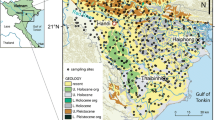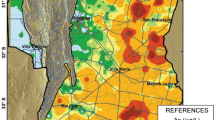Abstract
Dissolved arsenic (As) concentrations detected in groundwater bodies of the Emilia-Romagna Region (Italy) exhibit values which are above the regulation limit and could be related to the natural composition of the host porous matrix. To support this hypothesis, we present the results of a geochemical modeling study reproducing the main trends of the dynamics of As, Fe, and Mn concentrations as well as redox potential and pH observed during batch tests performed under alternating redox conditions. The tests were performed on a natural matrix extracted from a deep aquifer located in the Emilia-Romagna Region (Italy). The solid phases implemented in the model were selected from the results of selective sequential extractions performed on the tested matrix. The calibrated model showed that large As concentrations have to be expected in the solution for low crystallinity phases subject to dissolution. The role of Mn oxides on As concentration dynamics appears significant in strongly reducing environments, particularly for large water–solid matrix interaction times. Modeled data evidenced that As is released firstly from the outer surface of Fe oxihydroxides minerals exhibiting large concentrations in water when persistent reducing conditions trigger the dissolution of the crystalline structure of the binding minerals. The presence of organic matter was found to strongly affect pH and redox conditions, thus influencing As mobility.

Graphical Abstract





Similar content being viewed by others
References
Alexandratos VG, Elzinga EJ, Reeder RJ (2007) Arsenate uptake by calcite: macroscopic and spectroscopic characterization of adsorption and incorporation mechanisms. Geochimica et Cosmochimica Acta 71:4172–4187
Allison JDD, Brown S, Novo-Gradac KJ (1991) MINTEQA2/PRODEFA2, A geochemical assessment model for environmental systems: version 3.0 user's manual. Athens, GA, U.S. EPA
Berg M, Stengel C, Trang PTK, Hung Viet P, Sampson ML, Leng M, Samreth S, Fredericks D (2007) Magnitude of arsenic pollution in the Mekong and Red River Deltass Cambodia and Vietnam. Sci Total Environ 372(2–3):413–425
Brown JG, Glynn PD (2003) Kinetic dissolution of carbonates and Mn oxides in acidic water: measurement of in situ field rates and reactive transport modeling. Appl Geochem 18(8):1225–1239. doi:10.1016/S0883-2927(03)00010-6
Cama J, Ayora C, Lasaga AC (1999) The deviation-from-equilibrium effect on dissolution rate and on apparent variations in activation energy. GeochimCosmochim Acta 63:2481–2486
Chapelle FH, Haack SK, Adriaens P, Henry MA, Bradley PM (1996) Comparison of Eh and H2 measurements for delineating redox processes in a contaminated aquifer. Environ Sci Technol 30:3565–3569
Debnath S, Hausner DB, Strongin DR, Kubicki J (2010) Reductive dissolution of ferrihydrite by ascorbic acid and the inhibiting effect of phospholipid. J Colloid and Interface Science 341:215–223
Deuel LE, Swoboda AR (1972) Arsenic solubility in a reduced environment. Soil Sci Soc Am Proc 36:276–278
Doherty J (2004) PEST Model-Independent Parameter Estimation. User Manual (5th edn.). Watermark Numerical Computing, Australia
Duckworth OW, Martin ST (2004) Role of molecular oxygen in the dissolution of siderite and rhodochrosite. Geochimica et Cosmochimica Acta 68(3):607–621. doi:10.1016/S0016-7037(00)00464-2
Frohne T, Rinklebe J, Diaz-Bone RA, Du Laing G (2011) Controlled variation of redox conditions in a floodplain soil: impact on metal mobilization and biomethylation of arsenic and antimony. Geoderma 160:414–424. doi:10.1016/j.geoderma.2010.10.012
Gao Y, Mucci A (2001) Acid base reactions, phosphate and arsenate complexation, and their competitive adsorption at the surface of goethite in 0.7 M NaCl solution. Geochim Cosmochim Acta 65:2361–2378
Harvey MC, Schreiber ME, Rimstidt JD, Griffith MM (2006) Scorodite dissolution kinetics: implications for arsenic release. Environ Sci Technol 40:6709–6714
Hess RE, Blanchar RW (1977) Dissolution of arsenic from waterlogged and aerated soil. Soil Sci Soc A J 41:861–865
Höhn R, Isenbeck-Schröter M, Kent DB, Davis JA, Jakobsen R, Jann S, Niedan V, Scholz C, Stadler S, Tretner A (2006) Tracer test with As(V) under variable redox conditions controlling arsenic transport in the presence of elevated ferrous iron concentrations. J Contam Hydrol 8:36–54
Jönsson J, Sherman DM (2008) Sorption of As(III) and As(V) to siderite, green rust (fougerite) and magnetite: implications for arsenic release in anoxic groundwaters. Chem Geol 255:173–181
Lumsdon DG, Meeussen JCL, Paterson E, Garden LM, Anderson P (2001) Use of solid phase characterization and chemical modelling for assessing the behaviour of arsenic in contaminated soils. Appl Geochem 16:571–581
Marcaccio M, Martinelli G, Messori R, Vicari L (2005) Processi di rilascio dell'arsenico nelle acque sotterranee dell'Emilia-Romagna. Presenza e diffusione dell'arsenico nel sottosuolo e nelle risorse idriche italiane, nuovi strumenti di valutazione delle dinamiche di mobilizzazione. Agenzia Regionale Prevenzione e Ambiente dell'Emilia-Romagna, pp. 199–208
Martinelli G, Marcaccio M, Farina M, Canepa P, Cantagalli L, Billi L (2005) L'arsenico nei sedimenti profondi della pianura emiliano-romagnola: prime evidenze, in: Presenza e diffusione dell'arsenico nel sottosuolo e nelle risorse idriche italiane, nuovi strumenti di valutazione delle dinamiche di mobilizzazione. Agenzia Regionale Prevenzione e Ambiente dell'Emilia-Romagna. pp. 215–224. ISBN 88-87854-17-3
Matis KA, Zouboulis AI, Malamas FB, Afonso MDR, Hudson MJ (1997) Flotation removal of As(V) onto goethite. Environ Pollut 97:239–245
McGeehan SL (1996) Arsenic sorption and redox reactions: relevance to transport and remediation. J Environ Sci Health Part A 31:2319–2336
Molinari A, Guadagnini L, Marcaccio M, Guadagnini A (2012) Natural background levels and threshold values of chemical species in three large-scale groundwater bodies in Northern Italy. Sci Total Environ 425:9–19. doi:10.1016/j.scitotenv.2012.03.015
Molinari A, Guadagnini L, Marcaccio M, Straface S, Sanchez-Vila X, Guadagnini A (2013) Arsenic release from deep natural solid matrices under experimentally controlled redox conditions. Sci Total Environ 444:231–240. doi:10.1016/j.scitotenv.2012.11.093
Morse JW, Arvidson RS (2002) The dissolution kinetics of major sedimentary carbonate minerals. Earth Sci Rev 58(1–2):51–84. doi:10.1016/S0012-8252(01)00083-6
Nath B, Chakraborty S, Burnol A, Stüben D, Chatterjee D, Charlet L (2009) Mobility of arsenic in the sub-surface environment: an integrated hydrogeochemical study and sorption model of the sandy aquifer materials. J Hydrol 364:236–248
Parkhurst DL, Appelo CAJ (1999) User's guide to PHREEQC (version 2)—A computer program for speciation, batch-reaction, one-dimensional transport, and inverse geochemical calculations. US Geol. Surv, Water-Resour Invest Rep. 99–4259
Postma D, Larsen F, Minh Hue NT, Duc MT, Viet PH, Nhan PQ, Jessen S (2007) Arsenic in groundwater of the Red River flS. Arsen, Vietnam: controlling geochemical processes and reactive transport modeling. Geochim Cosmochim Acta 7:5054–5071
Ricci Lucchi F (1984) Flysch, molassa, cunei clastici: tradizione e nuovi approcci nell'analisi dei bacini orogenici dell'Appennino settentrionale (Flysh, molassa, clastic deposits: traditional and innovative approaches to the analysis of north Apeninic basins). Cento Anni di Geologia Italiana. Volume Giubilare 1° centenario Soc Geol Ital, pp. 279–295
Roden EE (2003) Fe(III) oxide reactivity toward biological versus chemical reduction. Environmental Science & Technology 37(7):1319–1324. doi:10.1021/es026038o
Sharif MU, Davis RK, Steele KF, Kim B, Hays PD, Kresse TM, Fazio JA (2008) Distribution and variability of redox zones controlling spatial variability of arsenic in the Mississippi River Valley alluvial aquifer, southeastern Arkansas. J Contam Hydrol 99:49–67
Smedley PL, Kinniburgh DG (2002) A review of the source, behaviour and distribution of arsenic in natural waters. Appl Geochem 17:517–568
Steefel CL, Lasaga AC (1994) A coupled model for transport of multiple chemical species and kinetic precipitation/dissolution reactions with application to reactive flow in single phase hydrothermal systems. Am J Sci 294:529–592
Torres E, Auleda M (2013) A sequential extraction procedure for sediments affected by acid mine drainage. J Geochem Explor 128:35–41. doi:10.1016/j.gexplo.2013.01.012
Zavatti A, Attramini D, Bonazzi A, Boraldi V, Malagò R, Martinelli G et al. (1995) La presenza di arsenico nelle acque sotterranee della pianura padana: evidenze ambientali e ipotesi geochimiche. In: Pitagora (ed) Quaderni di Geologia Applicata, Bologna, pp. 301–326
Acknowledgments
The research has been performed in the framework of a research agreement between the Politecnico di Milano and ARPA—Regional Agency for Environmental Protection. Funding from ARPA and the Emilia-Romagna Region is gratefully acknowledged. X. S. acknowledges support from ICREA Academia program.
Author information
Authors and Affiliations
Corresponding author
Additional information
Responsible editor: Céline Guéguen
Highlights
As displays a rapid release rate under rapidly varying redox conditions
Organic matter strongly affects Eh and pH conditions and dynamics of As release
Large As release occurs when low crystallinity phases are subject to dissolution
Mn oxides dissolution could be crucial on As release after long solid–water contact
Our geochemical model reproduces key experimental trends of As, Fe, Mn, Eh, and pH
Rights and permissions
About this article
Cite this article
Molinari, A., Ayora, C., Marcaccio, M. et al. Geochemical modeling of arsenic release from a deep natural solid matrix under alternated redox conditions. Environ Sci Pollut Res 21, 1628–1637 (2014). https://doi.org/10.1007/s11356-013-2054-6
Received:
Accepted:
Published:
Issue Date:
DOI: https://doi.org/10.1007/s11356-013-2054-6




